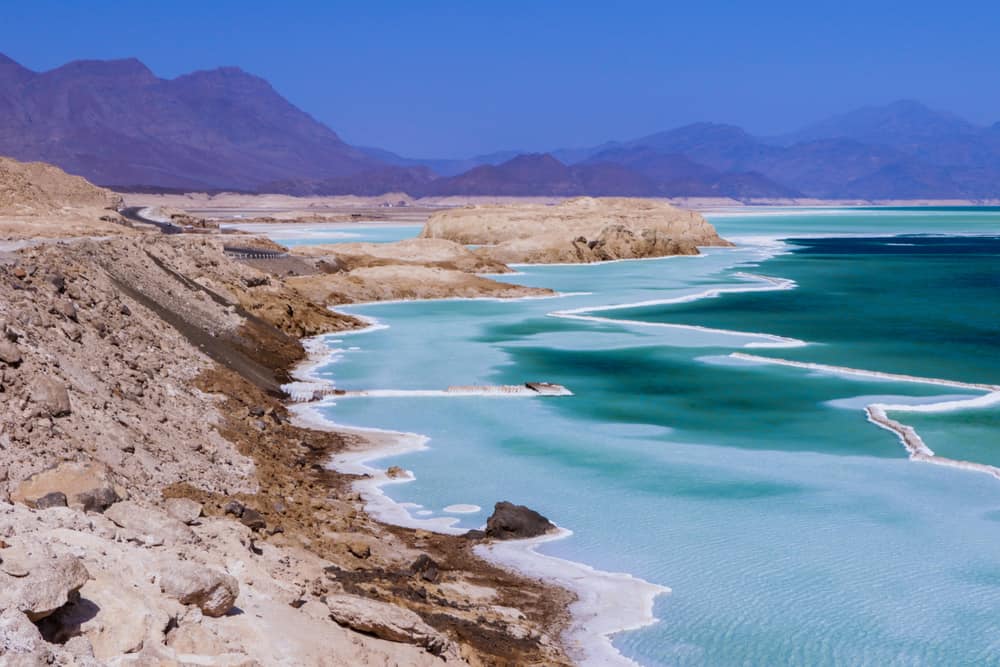Summary
Djibouti certainly belongs to the category of small regions that offer great rewards. Although it occupies a modest area in Northern Africa, it is rich in beauty and features that one truly cannot comprehend unless experienced firsthand.
Few destinations boast such a diverse array of landscapes—encompassing volcanoes, sinking plains, limestone columns emitting steam, salt lakes, majestic canyons, and stunning plateaus.
For enthusiasts of outdoor activities, there is an abundance of opportunities to engage. Activities such as snorkeling with sharks, diving, kite surfing, and hiking await. The country is relatively undeveloped outside the capital, ensuring a remarkable eco-travel experience that allows a glimpse into ancient nomadic existence.
While costs can be on the higher side, visitors should arrive well-prepared, as these expenses are more than justified by the unforgettable experiences that await. Below are the top destinations to explore in Djibouti!
1. Djibouti City

Djibouti City serves multiple functions. Initially, it acts as an excellent base for excursions into the interior or out to sea. Additionally, it offers a modicum of comfort upon returning from those adventures.
The city features good restaurants, bars, and hotels, ensuring that visitors can anticipate certain creature comforts.
Furthermore, it is genuinely endearing and hard not to love. One can observe a distinct transformation occurring as the populace strives to revitalize their city, which had previously suffered neglect during the 1980s and 1990s.
It is a veritable melting pot, showcasing a variety of cultural contrasts that are delightful to witness.
2. Lake Assal

Known as “Honey Lake,” this crater lake lies at the western end of the Gulf of Tadjoura. It is situated 155 meters below sea level, making it the second lowest land depression on Earth after the Dead Sea.
Lake Assal holds the title of the largest salt reserve, which the local populace regards as a national treasure.
Currently, the site is in the process of being designated a UNESCO World Heritage site, and the surrounding views are nothing short of spectacular.
3. Tadjoura

This town ranks among the oldest on the eastern coast of Africa, with origins tracing back at least to the 12th century.
Once governed by a sultan, Tadjoura was a significant port for trade between Djibouti and Ethiopia, including the unfortunate slave trade.
Affectionately called La Ville Blanche, or White Town, it is named for the many charming whitewashed buildings that adorn the area. The town is conducive to walking and affords splendid views of the waterfront. In the late afternoons, the streets come alive with locals.
A multitude of mosques can also be visited, and one can relish the tranquil ambiance that distinguishes this less hectic version of Djibouti City.
4. Ali Sabieh

Positioned near the borders of Somalia and Ethiopia, Ali Sabieh is encircled by magnificent desert landscapes.
Within the city, visitors will encounter numerous vibrant markets, food stalls, and narrow streets. This region epitomizes rustic and unrefined Africa at its finest. Surprisingly, nearby natural beauty remains largely untouched by tourists.
To experience the desert in its full glory, one should explore Grand Bara and Petit Bara. Engaging in wind surfing or any of the various adventure sports is also recommended, as the entire vicinity is renowned for its challenging hiking trails.
5. The Gulf of Tadjoura

Embellished by the lush Goda Mountains, which rise up to 1300 meters, the Gulf of Tadjoura is regarded by many as the ideal location for diving and snorkeling with whale sharks.
The two towns that tend to attract the greatest attention from visitors are Obock and Tadjoura.
In Tadjoura, one can enjoy stunning coastal views and seven mosques of national significance.
6. Goba’ad Plain

This region, situated between Lake Abhe and the Hanlé Plain, constitutes an excellent destination for bird watching.
Goba’ad is the sole region in Djibouti with an active breeding population of ostriches. Additionally, one can sight Black Crown Sparrows, Arabian Bustards, Sand Grouses, Crombecs, and a range of other avian species.
This lowland area is characterized by shallow wadis, expansive sand flats, and acacia scrub, rendering it an attractive location for nature enthusiasts.
7. Hanlé Plain

Adjacent to the Goba’ad Plain, this ecosystem shares similar characteristics.
The lowland valley is encircled by steep mountains and features several small freshwater lakes.
This area is yet another prime site for bird enthusiasts, with opportunities to observe Egyptian Geese, Black Crakes, and Three-Banded Plovers.
8. Doralé and Khor Ambado

These two stunning beaches are situated approximately 15 km from Djibouti City. They provide excellent swimming opportunities alongside black lava cliffs that line the shore.
Local sightseeing excursions often embark from this location, and various water sports are readily available.
The sunsets at Khor Ambado are frequently cited as the most breathtaking in the country. Should you desire to unwind with a few days of sun and surf, this would be an ideal destination.
9. Tropical Aquarium

This facility ranks among the primary attractions in the country. Located in the historic district, it is considered one of the finest in all of Africa.
The design provides an immersive experience that simulates being submerged in the Red Sea, allowing visitors to observe marine life in this unique ecological setting. The ecosystems showcased are meticulously restored and recreated.
Complement your visit with a trip to Marche Central, the vibrant and bustling central market, providing a delightful afternoon outing in the city.
10. Day Forest National Park

This expansive oasis bursts with the vibrant hues of the Djibouti desert. Located approximately 20 km from the Gulf of Tadjoura, naturalists are sure to be captivated by Day Forest National Park.
Encircled by desert, this location is one of two designated protected forested areas in the nation. It stands as the largest forest, with its most significant ecosystem being the 900-hectare stand of East African Junipers, which can reach heights of nearly 1000 meters.
With some luck, visitors may encounter the Toha or Djibouti sunbird, both of which have only been observed within the forest.





